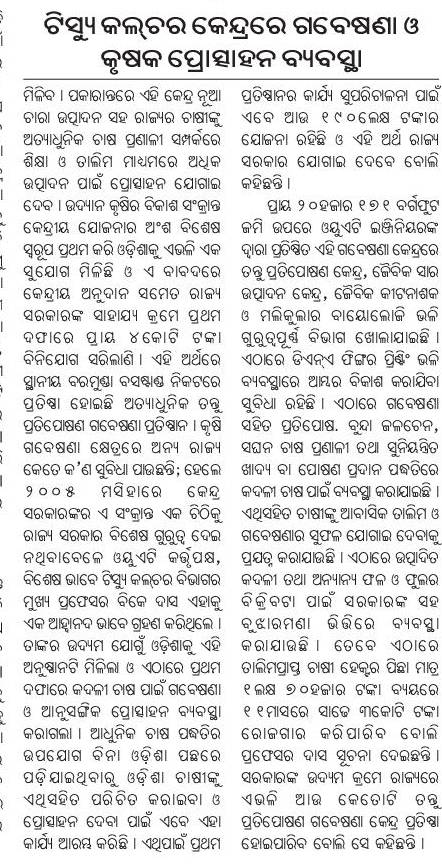(The PIB report is at http://pib.nic.in/release/release.asp?relid=47274.)
The following is excerpted from a report in Hindu.
The Union Cabinet on Thursday approved two more AIIMS-like medical institutions, one in West Bengal and the other in Uttar Pradesh, at a cost of Rs.823 crore each. The Cabinet also decided to upgrade five government medical colleges in five States to the level of the All-India Institute of Medical Sciences in New Delhi.
Announcing this, Union Home Minister P. Chidambaram said: “The proposed institution in West Bengal will come up at Raiganj in North Dinajpur district. The site for the AIIMS-like college and hospital in UP has not yet been identified.”
Raiganj is represented in the Lok Sabha by the ailing Union Minister Priyaranjan Dasmunsi.
Each institution, to be set up under the second phase of the Pradhan Mantri Swasthya Suraksha Yojna (PMSSY), will have a 960-bed hospital and will provide health care facilities in 39 speciality or super-speciality disciplines.
There will be 500 beds for the medical college hospital, 300 for speciality or super-speciality, 100 for ICU or accident trauma, 30 for physical medicine and rehabilitation and 30 beds dedicated to Ayush (Ayurvedic, Unani, Siddha, Homoeopathy).
The medical college will have a hundred under-graduate intake, besides facilities for imparting post-graduate or doctoral courses and a nursing college.
The Cabinet also approved upgrading of the government medical colleges in Amritsar (Punjab), Tanda (Himachal Pradesh), Madurai (Tamil Nadu), Nagpur (Maharashtra) and Jawaharlal Nehru Medical College of Aligarh Muslim University.
The upgrading of each of these medical colleges will be done at an estimated cost of Rs.150 crore. Of this, the Centre will contribute Rs.125 crore and a minimum of Rs.25 crore will be borne by the respective State governments.
In respect of Aligarh Muslim University, Rs.25 crore will be provided by the Union Ministry of Human Resource Development.
With these additions to the earlier list the state wise distributions of AIIMS and the proposed institutes are as follows:
| State |
New or existing AIIMS or AIIMS-like Institute and location [1 + 8 ]
|
Upgradation [13 + 5] |
| Delhi |
AIIMS, Delhi |
|
| Orissa |
Bhubaneswar |
|
| Bihar |
Patna |
|
| Madhya Pradesh |
Bhopal |
|
| Uttarakhand |
Rishikesh |
|
| Rajasthan |
Jodhpur |
|
| Chhatisgarh |
Raipur |
|
| West Bengal |
Raiganj (North Dinapur dist) |
Kolkata Medical College |
| Uttar Pradesh |
Place not decided |
Sanjay Gandhi Post Graduate Institute of Medical Sciences, Lucknow
Institute of Medical Sciences, BHU, Varanasi
Jawaharlal Nehru Medical College of Aligarh Muslim University (Phase 2)
|
| J & K |
|
Govt. Medical College, Jammu.
Govt Medical College, Srinagar
|
| Andhra Pradesh |
|
Nizam Institute of Medical Sciences, Hyderabad
Sri Venkateshwara Institute of Medical Sciences, Tirupati
|
| Tamil Nadu |
|
Govt. Medical College, Salem
Govt. Medical College, Madurai (Phase 2)
|
| Jharkhand |
|
Rajendra Institute of Medical Science (RIMS), Ranchi |
| Gujarat |
|
B.J. Medical College, Ahmedabad |
| Karnataka |
|
Bangalore Medical College, Bangalore |
| Maharashtra |
|
Grant Medical College & Sir J.J. Group Of Hospitals, Mumbai
Govt. Medical College, Nagpur (Phase 2)
|
| Kerala |
|
Medical College, Thrivananthapuram |
| Punjab |
|
Govt Medical College, Amritsar (Phase 2) |
| Himachal Pradesh |
|
Govt Medical College, Tanda (Phase 2) |
| Assam, Arunachal Pradesh, Manipur, Meghalaya, Mizoram, Nagaland, Sikkim, Tripura, Goa, Haryana, |
|
|
February 6th, 2009
Author : Chitta Baral
The web page is http://www.iitbbs.ac.in/. Thanks to Prof. Ramachandra Rao for this pointer. The web sites of the new IITs are:
February 4th, 2009
Author : Chitta Baral
Following is from PIB http://pib.nic.in/release/release.asp?relid=47087.
The Union Cabinet has approved the establishment of a new institute “National Institute ofAbiotic Stress Management” costing Rs. 73.50 crores in the 11th Plan.
Abiotic stresses like drought, temperature extremes, flood, salinity, mineral toxicity and nutritive deficiency are threatening agriculture production globally. India being a tropical country faces such abiotic stresses to a significant degree which has implications for maintaining national food security.
The National Institute of Abiotic Stress Management shall have a comprehensive mandate of characterization of the occurrence of various abiotic stresses in the country impacting agriculture on a continuous basis and carry out basic and strategic research that will lead to development of technologies for mitigation and adoptation of crops, livestock, horticulture, fisheries and micro organisms to such stresses. The important research programs would be in a matrix mode. Organizationally it is proposed that the institute shall conduct its research programmes through four schools viz; schools of drought stress management, atmospheric stress management, edaphic stress management and policy support research.
The institute, which will be located at Malegaon ( Baramati) in Maharashtra will have a deemed to be university status.
February 1st, 2009
Author : Chitta Baral
Following is from a report in Pioneer.
… The State Higher Education Department has brought up a proposal for an ICFAI University Bill to the State Cabinet for its approval on Sunday.
This will be the third private university Bill to be presented to the State Legislative Assembly. Earlier, the Vedanta University and Sri Sri University Bills were presented in the legislature and are pending for their approval. The next Assembly session will begin from February 9.
According to sources, the ICFAI, which signed an MoU with the State Government on March 20, 2007 to set up a World Class Multidisciplinary University, is waiting for an exclusive Act. The ICFAI will set up a core campus near Jatni to cater to the needs of 1,000 students.
Its disciplines include Basic Science, Humanities, Engineering, Business Management, Finance, Accounting, Economics, Law, Bio-Sciences, Environmental Science and Management, Tourism and Hospitality Management and Media and Mass Communication.
The university, which has also come up with an investment of Rs 150 crore, will promote research by setting up Centres of Excellence in its disciplines. It will be a fully residential campus for the students and faculty members.
February 1st, 2009
Author : Chitta Baral
Among the founding directors of all the new IITs, the founding director of IIT Bhubaneswar, Prof. Madhusudan Chakrabarti, seems to have the most administrative experience. His following interview to the IIT Kharagpur Scholars Avenue magazine shows his involvement in the expansion activities at IIT Kharagpur. It also shows his experience in dealing with tough issues.
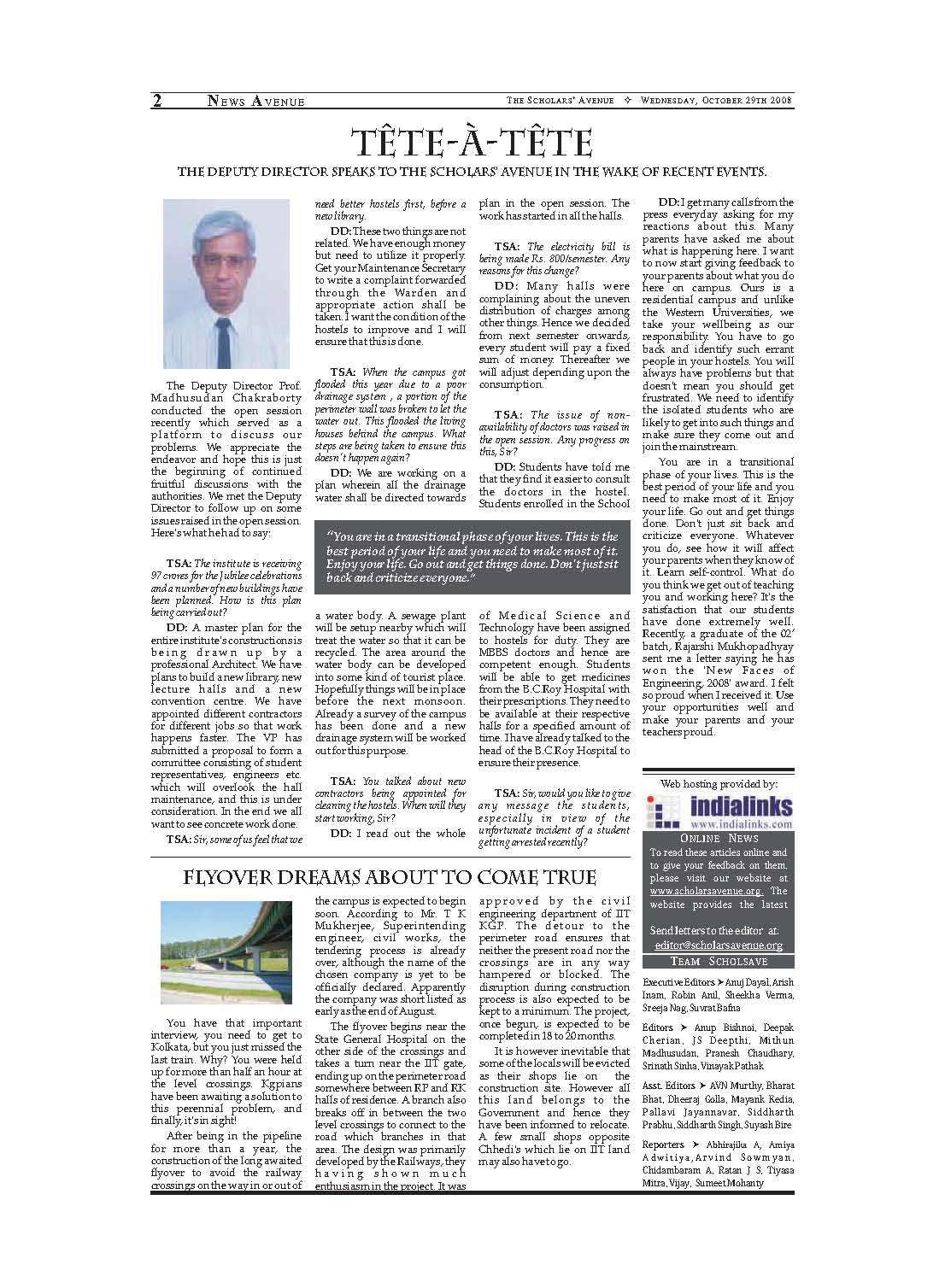
February 1st, 2009
Author : Chitta Baral
Following is from a report in Pioneer.
Prof. Madhusudan Chakrabarti will be appointed as the chief of the IIT, Orissa. Prof Chakrabarti is currently working as Deputy Director in IIT, Kharagpur. He is a Professor in Metallurgical & Materials Engineering. He is also a Life Member of the Indian Institute of Metals and Materials Research Society of India.
The following excerpt from a report in Telegraph lists the directors of all the six new IITs.
Directors to six new IITs were also appointed at today’s meeting. U.B. Desai, an electrical engineer from IIT Bombay, will head IIT Hyderabad. M.K. Surappa, who teaches metallurgy at IIT Delhi, will be the director of IIT Roopnagar (Punjab). IIT Kanpur civil engineer Sudhir Jain will head the IIT in Gandhinagar. Anil Bhowmick, from IIT Kharagpur’s rubber technology centre, will be the director of IIT Patna. IIT Kharagpur deputy director Madhusudan Chakraborty will head IIT Bhubaneswar.
This Times of India report names the IIT Rajasthan director as Prem Kalra.
January 29th, 2009
Author : Chitta Baral
Among the 28 central schools for Tibetans, one of them is in Chandragiri of Gajapati district, Orissa. Following is information about that school from this page.
CST Chandragiri is located in the Eastern Ghat region at the height of 1900 feet above sea level, about 250 kilometres away from Bhubaneswar, the capital city of the state of Orissa. The school was established in Phuntsokling Tibetan Settlement in the year 1965 with the blessing of His Holiness the Dalai Lama and managed by Central Tibetan Schools Administration, Delhi, an autonomous body under the Ministry of Human Resource Development, Govt. of India. The school was established to impart modern education and to preserve and promote the rich Tibetan cultural heritage to the children of Tibetan refugees settled in Orissa.
At present the school has two primary school branches, one at Lobersing Camp No. 3 and another at Mahendragarh Camp No. 5 each with a headmaster. The main secondary school at Chandragiri has classes from VI to X. The school has a total strength of 345 students including both the branch schools. Tibetan is the medium of instruction at the primary classes and English in middle and secondary classes. The school is affiliated to the Central Board of Secondary Education (CBSE), Delhi and follows textbooks published by the National Council of Educational Research and Training (NCERT) and CBSE. The total staff strength is 32, which includes 23 teaching staff. The academic performance of the school continues to show improvement and the result of Class X CBSE Board examination held in March 2004 was 92.31% as against 52.77% last year.
The school has good facilities viz. spacious playgrounds, multi-purpose halls, computer lab, senior & junior science labs, audio-visuals, resource centre, library, OHP, art and tailoring sections. The Settlement Officer and Parent-Teacher Association take active interest in the development of the school.
January 29th, 2009
Author : Chitta Baral
(Thanks to Abi for the pointer.)
Following is excerpted from a report in India Today.
… The academic-turned prime minister chose to call them ‘World Class Universities’, sexing up the comeget-me factor. “These universities should focus on international standards of excellence and be rated among the top institutions in the world. They must become the launching pads for our entry into the knowledge economy,” Manmohan said at a function held to celebrate 150 years of the University of Mumbai in June 2007.
… The chances of missing the February deadline to pass the bill in the short session of Parliament are high and the Government is looking at the possibility of pushing it through an ordinance.
…The UGC is of the view that the universities should be run by the government and wants to underplay the role of private players and corporates.
The ministry on its part is ready to open it up to “creditable private organisations” and offer them public land. The Knowledge Commission has a different take.
“Since public finance is an integral constituent of universities worldwide, most of the new universities shall need significant initial financial support from the Government. Each university may be endowed with a substantial allocation of public land, in excess of its spatial requirements,” says Sam Pitroda, chairman, NKC.
The excess land can be a subsequent source of income generation, he says. Exceptions need to be made in existing income tax laws to encourage large endowments.
… The NKC in its letter to the UGC chairman has also suggested that the syllabi should be revised every year to keep up with the changes and current developments in various disciplines. “Departments that do not update their syllabi for two consecutive years shall be asked to provide justifications,” says the letter. Another contentious issue is that of fixing fees and granting autonomy to the proposed universities.
The commission had envisaged that these universities shall have the autonomy to set student fee levels and tap other sources for generating funds such as industry collaborations and overseas operations. The autonomy of fees and greater autonomy for each university is a strict no-no for both the ministry as well as the UGC. Prompted by incisive memos from the Prime Minister’s Office, which is attuned with the views of the NKC, the ministry is planning to prepare a bill with critical minimum provisions, thereby enabling autonomy and innovation without going through a parliamentary process at a later stage. Otherwise, it will have to resort to the ordinance route, bypassing Parliament.
… As a first step, the ministry has decided to do away with the tag of World Class University, an idea which has won it the NKC’s applause . The Act will now be termed the National Universities System Act instead of the World Class University System Act.
Hope the people who wonder about Vedanta University’s land requirement will get a better understanding of it from the NKC’s suggestion regarding providing excess land to the proposed National Universities.
January 26th, 2009
Author : Chitta Baral
Following is from a report in Pioneer.
The Centre has approved a proposal to set up four polytechnics in Malkangiri, Boudh, Gajapati and Sambalpur districts of the State.
In order to lure the youth of the Maoist-predominant areas towards technical education the Union Ministry of Human Resource Development (MHRD) has chalked out a plan to establish more diploma engineering institutions. Orissa being largely affected by Leftwing extremism has been benefited handsomely. Malkangiri is the State’s worst Maoist-hit district.
While each polytechnic will be established at the cost of Rs 12 crore, the MHRD has provided Rs 8 crore as the first installment. Technical Education Director Vir Vikaram Yadav said the State Government is planning to establish polytechnics in all districts. The State now has 13 polytechnics, while there are seven such private institutions imparting diploma in engineering.
With the four new institutions planned, many other districts are still left out. The new districts carved out in the 1990s, Kendrapada, Jagatsinghpur, Bhadrak, Nayagarh, Nabarangpur and Subarnapur do not have any polytechnic.
Yadav said that the State Government also decided to cover all the blocks with Industrial Training Institutes (ITIs). Accordingly, plans are afoot to cover 125 blocks which are yet to have an ITI.
January 25th, 2009
Author : Chitta Baral
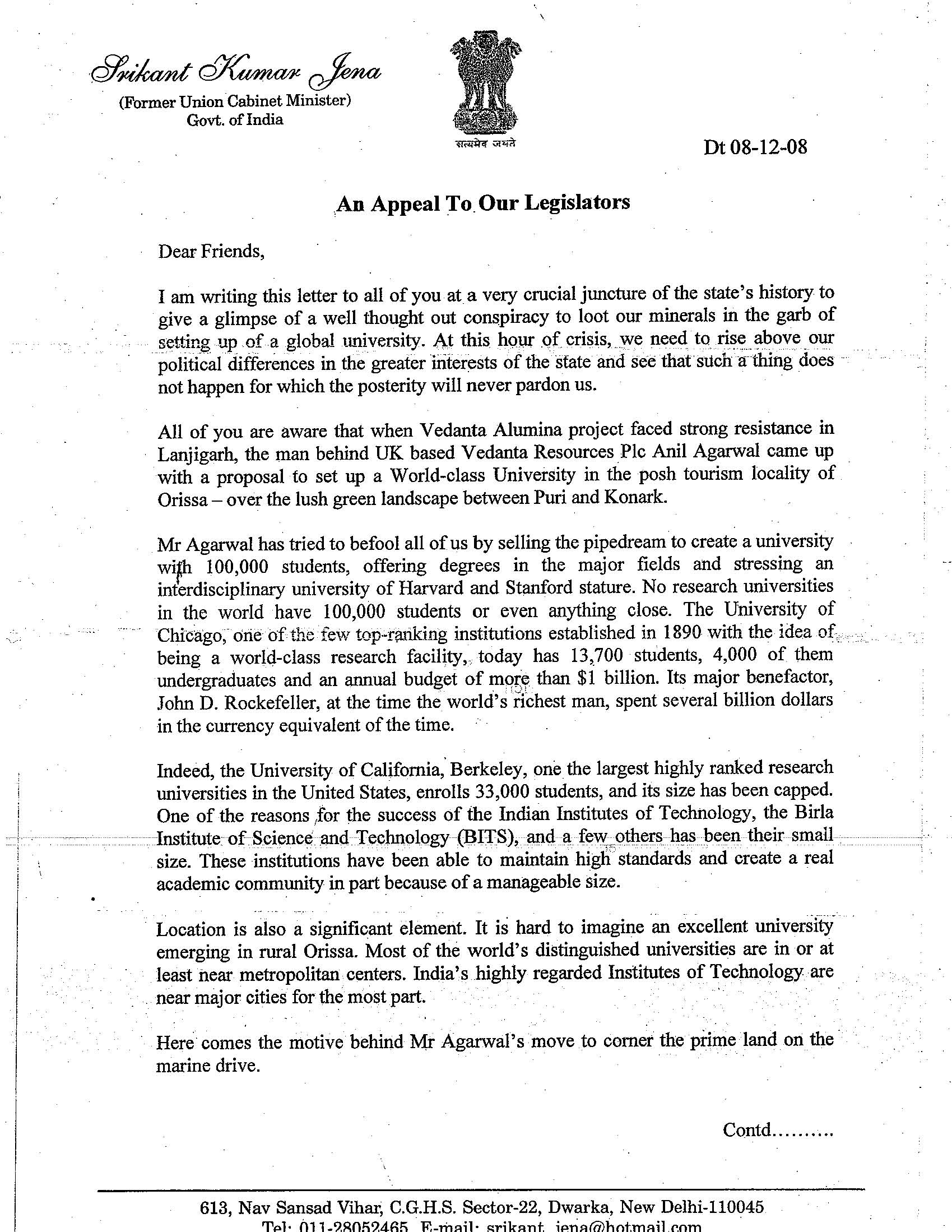

I would now like to rebut the couple of points mentioned in the above writing.
(i) In regards to the size it is true that no world class university currently has 100,000 students. However, several of them have around 50,000 students. Please see Q6 of https://www.orissalinks.com/archives/1696. Some of them, especially Arizona State University, expects to reach a size of 85,000 by 2030. Moreover, one must note that Vedanta University aims to have 100,000 students at build out, which may be in 20-25 years or beyond.
(ii) On the issue of minerals, one just has to make sure that it is explicitly mentioned that any mineral from that land becomes state property and have a mechanism to monitor it.
(iii) On why in a rural location; the Vedanta University location is about 40 kms from the outer edges (Jatni) of the Bhubaneswar area. With plans to connect it by a 4-lane highway it will only take 25-45 minutes to get there from various points in Bhubaneswar. Also, most the new IITs that are coming up, especially IITs in Hyderabad, Punjab, Patna and Indore, are 25-50 kms from the airports or city center of their respective metropolitan areas.
January 20th, 2009
Author : Chitta Baral
Following is an excerpt from a report in Telegraph.
New Delhi, Jan. 16: President Pratibha Patil has promulgated an ordinance allowing the government to establish 15 new central universities despite last-minute objections by the National Knowledge Commission that the ordinance would hurt higher education.
The President signed the ordinance late last night even as the commission headed by Sam Pitroda tried to convince the Prime Minister and senior government officials against the move.
Patil’s signature triggered a chain of events today that saw the human resource development ministry launch a process of selection of vice-chancellors within hours.
It has also set off fireworks between the commission and the ministry, which the commission believes is keen to retain control over universities while officially calling them autonomous.
… The government is keen to start classes at the universities in the 2009 academic session, said the ministry note to the President.
The ministry, a top HRD official said, will bring the ordinance before both Houses when Parliament meets briefly in February. “We want the ordinance to be cleared by both Houses in the narrow slot for which the Parliament is meeting so that we can start classes from 2009,” the official said.
An ordinance needs parliamentary ratification within six months.
One of the above mentioned 15 universities will be in Orissa; Earlier the Orissa government recommended the Koraput area as the site of this university. As per the bill, available here, the one in Orissa will be called Central University of Orissa.
An earlier copy of the bill (before Goa University was taken out) is available here. There was last minute criticism of the bill and request to not promulgate it as an ordinance by the National Knowledge Commission. See news reports on this here and here. But the President promulgated the ordinance anyway.
January 18th, 2009
Author : Chitta Baral
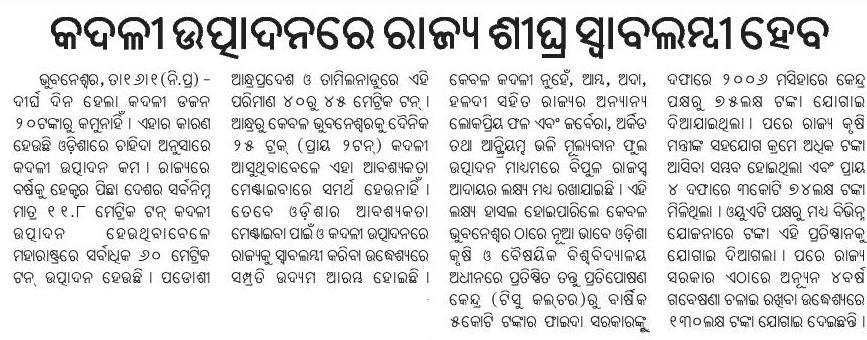
January 17th, 2009
Author : Chitta Baral
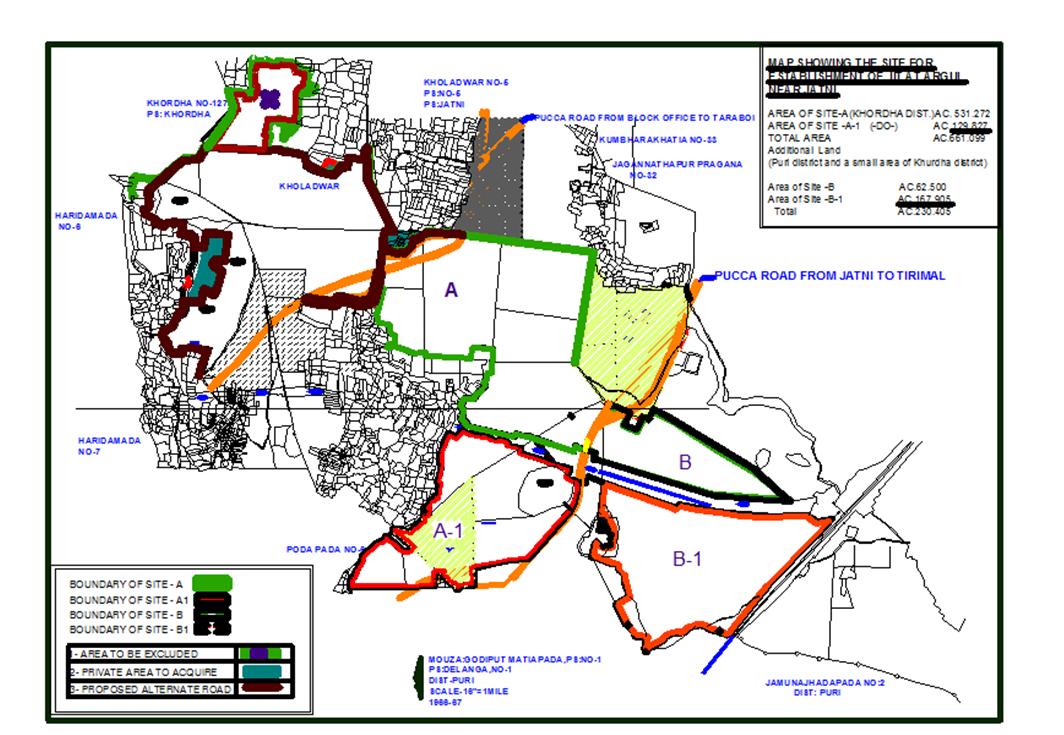
January 17th, 2009
Author : Chitta Baral
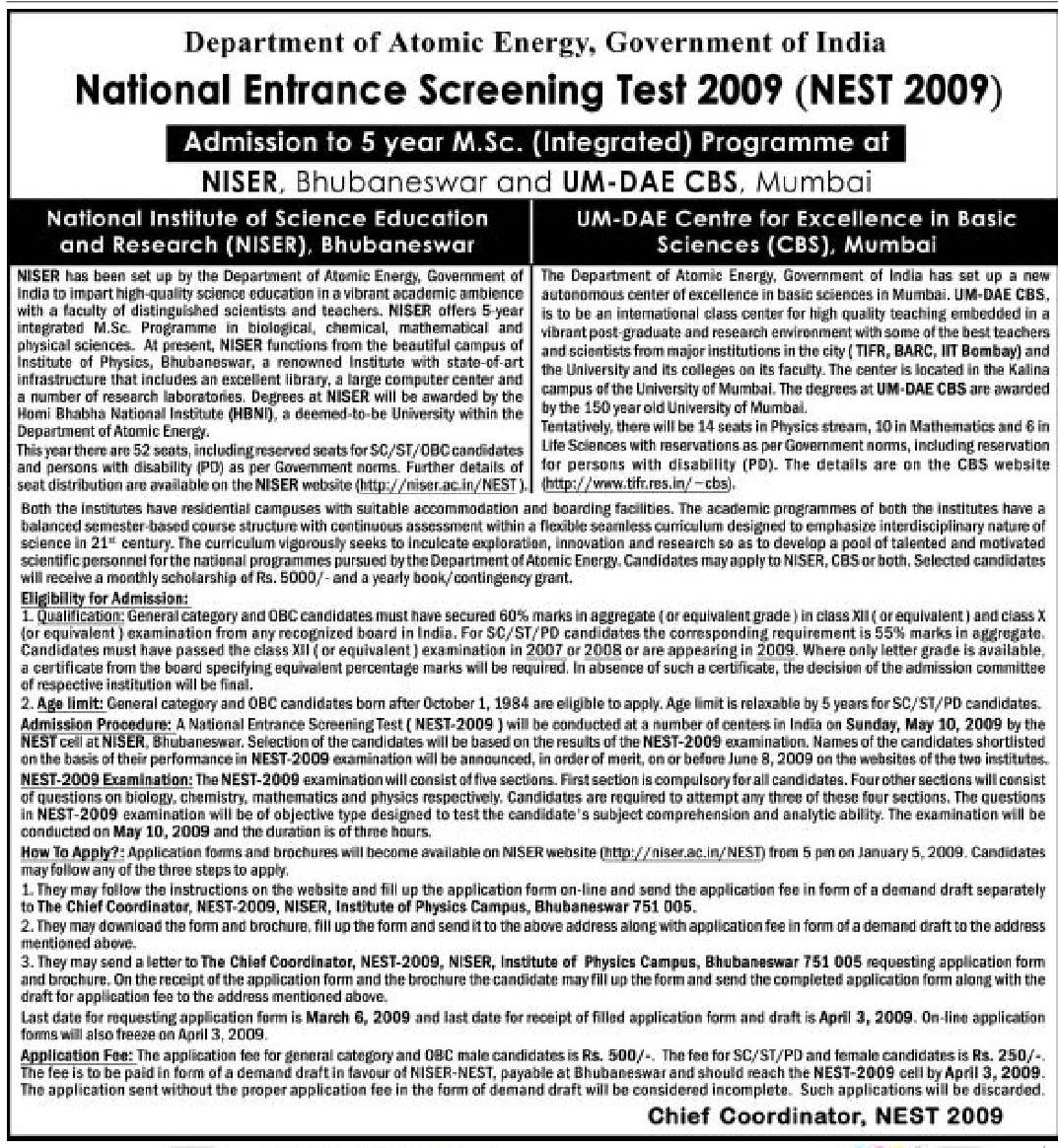
Unlike the IISERs that take students from the IIT exams and KVPY, NISER Bhubaneswar (an IISER-equivalent institute that is funded by DAE) teams up with UM-DAE and has its own exam called NEST. (They also took students from KVPY.)
The following information regarding NEST 2009 is from http://niser.ac.in/NEST/.
About NEST
National Entrance Screening Test (NEST) is a compulsory test for students seeking admission to National Institute of Science Education and Research (NISER), Bhubaneswar and University of Mumbai – Department of Atomic Energy Centre for Excellence in Basic Sciences (UM-DAE CBS), Mumbai. Both NISER and UM-DAE CBS have been started by Department of Atomic Energy, Government of India in 2007. Their mandate is to train scientific manpower for carrying out cutting edge scientific research and for providing input to scientific programs of Department of Atomic Energy and other applied science institutions in the country. The test is conducted in more than 25 centers across India. This brochure gives the detailed procedure for applying for the test, syllabus of the test and various dead lines.
NEST Brochure 
About NISER
NISER has been set up by the Department of Atomic Energy, Government of India to impart high-quality science education in a vibrant academic ambience with a faculty of distinguished scientists and teachers. NISER offers 5-year integrated M.Sc. programme in biological, chemical, mathematical and physical sciences. At present, NISER functions from the beautiful campus of
Institute of Physics, Bhubaneswar, a renowned Institute with state-of-art infrastructure that includes an excellent library, a large computer center and a number of research laboratories. Degrees at NISER will be awarded by the Homi Bhaba National Institute (HBNI), a deemed-to-be University within the department of Atomic energy.
This year there are 52 seats, including reserved seats for SC/ST/OBC candidates and persons with disability (PD) as per Government norms. Further details about the institute can be found on the NISER website (http://niser.ac.in).
NISER Brochure 
About UM-DAE CBS
The Department of Atomic Energy, Government of India has set up a new autonomous center of excellence in basic sciences in Mumbai. UM-DAE CBS, is to be an international class center for high quality teaching embedded in a vibrant post-graduate and research environment with some of the best teachers and scientists from major institutions in the city (TIFR, BARC, IIT Bombay) and the University and its colleges on its faculty. The center is located in the Kalina campus of the University of Mumbai. The degrees at UM-DAE CBS are awarded by the 150 year old University of Mumbai.Tentatively, there will be 14 seats in Physics stream, 10 in Mathematics and 6 in Life Sciences with reservations as per Government norms, including reservation for persons with disability (PD). The details are on the CBS website (http://www.tifr.res.in/~cbs).
Important Dates
- Last date for request of application form : March 6, 2009
- Last date for receipt of completed application form with DD : April 3, 2009
- Online applications freeze : April 3, 2009
- Dispatch of offline admit cards begins : April 15, 2009
- Download of online admit cards begins : April 15, 2009
- Date of examination : May 10, 2009 (Sunday), 1 pm to 4 pm
- Announcement of results on NEST website : June 8, 2009
Eligibility for appearing NEST
Students securing at least 60% marks in aggregate (or equivalent grade) in Class XII (or equivalent) examination from any recognized Board in India are eligible to apply. For Scheduled Cast (SC), Scheduled Tribes (ST) candidates and for Persons with Disability (PD), the minimum requirement is 55%. Students who have passed the Class XII qualifying examination in 2007 or 2008 or are appearing in 2009 are eligible to apply. (Where only Letter grade is given by the Board, a certificate from the Board specifying equivalent percentage marks will be required. In the absence of such a certificate the decision of the respective Admissions Committee will be final.)
How to apply (3 ways)
- Online form submission is the most convenient and preferred way. Follow these steps to go for it.
- Register yourself before you login.
- Confirm your registration from a mail sent to you just after registration.
- Login in the NEST homepage with your mail-id and password.
- Fill the form and save it or, modify an already saved form.
- Take the print-out and send along with DD.
- Form can be downloaded, filled and sent back with DD. Download form NEST Brochure Please set margin in the browser page-setup to accomodate the form in a single A4 sheet.
- A letter of request can be sent to get the printed form by post. This form will have to be sent back along with DD after filling it properly.
January 13th, 2009
Author : Chitta Baral
Following is from the PTI report on this.
The government today approved an area of 935 acres near Jatni in Khurda district of Orissa as the site for the proposed IIT in the state.
"There were four possible sites for the top institute. But the government approved the location near Jatni as it has vast land area and is near to airport. The rail and road connectivity is very good to this place," a top HRD Ministry official told PTI here.
HRD Minister Arjun Singh will visit the state soon to lay the foundation stone for the elite technical institute, the official said.
He said the ministry had sent its site identification committee to the state on December 24 and 25 last year. The committee visited the sites near Jatni, Banki, Ramdaspur and Gayabandha.
"Among all the places, the committee found location near Jatni was the best from the point of view of future and growth prospects of the institute," he said.
… "The Centre also asked the state government to transfer the land to the IIT Society of IIT Bhubaneswar immediately so that the construction of the building and other facilities can be started," he said.
January 13th, 2009
Author : Chitta Baral
Following is from http://pib.nic.in/release/release.asp?relid=46517.
Shri G K Vasan, Minister of State (Independent charge), Ministry of Statistics & Programme Implementation said that the Government of India has plans for setting up three new universities for the benefit of the children of NRIs and PIOs. While addressing at the Regional Session on Carribean at the 7th Pravasi Bharatiya Divas, 2009 today at Chennai, he informed that the first of these universities to be located at Bangalore is expected to be operational by the year 2010. These universities would have a reservation of 50 per cent seats for NRIs and PIOs. The Government has also increased the number of scholarships to 120 to facilitate unhindered access to higher education for children of NRIs and PIOs who are not economically well off in their adopted lands, the Minister added.
January 10th, 2009
Author : Chitta Baral
Next Posts
Previous Posts




